ICT705 Data Integration: Developing a National E-Government System
VerifiedAdded on 2023/04/08
|12
|3196
|386
Report
AI Summary
This paper discusses the development of a national E-Government system, focusing on the benefits of Information-Centric designs and Enterprise Information Architecture Reference Architecture (EIA RA). It highlights the advantages of Information-Centric design, including scalability, robustness, and improved governmental services. Two key functions, Historical Reporting and Anticipate and Shape, are analyzed using information maturity models, demonstrating their impact on decision-making and risk management. The report also explores the application of EIA RA, emphasizing its role in minimizing costs, ensuring data security, and improving business, technical, and organizational architectures. The paper concludes by recommending the implementation of Information-Centric designs to enhance e-government systems.

Developing a national E-Government system
Name of the Student
Name of the University
Author Note:
Name of the Student
Name of the University
Author Note:
Paraphrase This Document
Need a fresh take? Get an instant paraphrase of this document with our AI Paraphraser
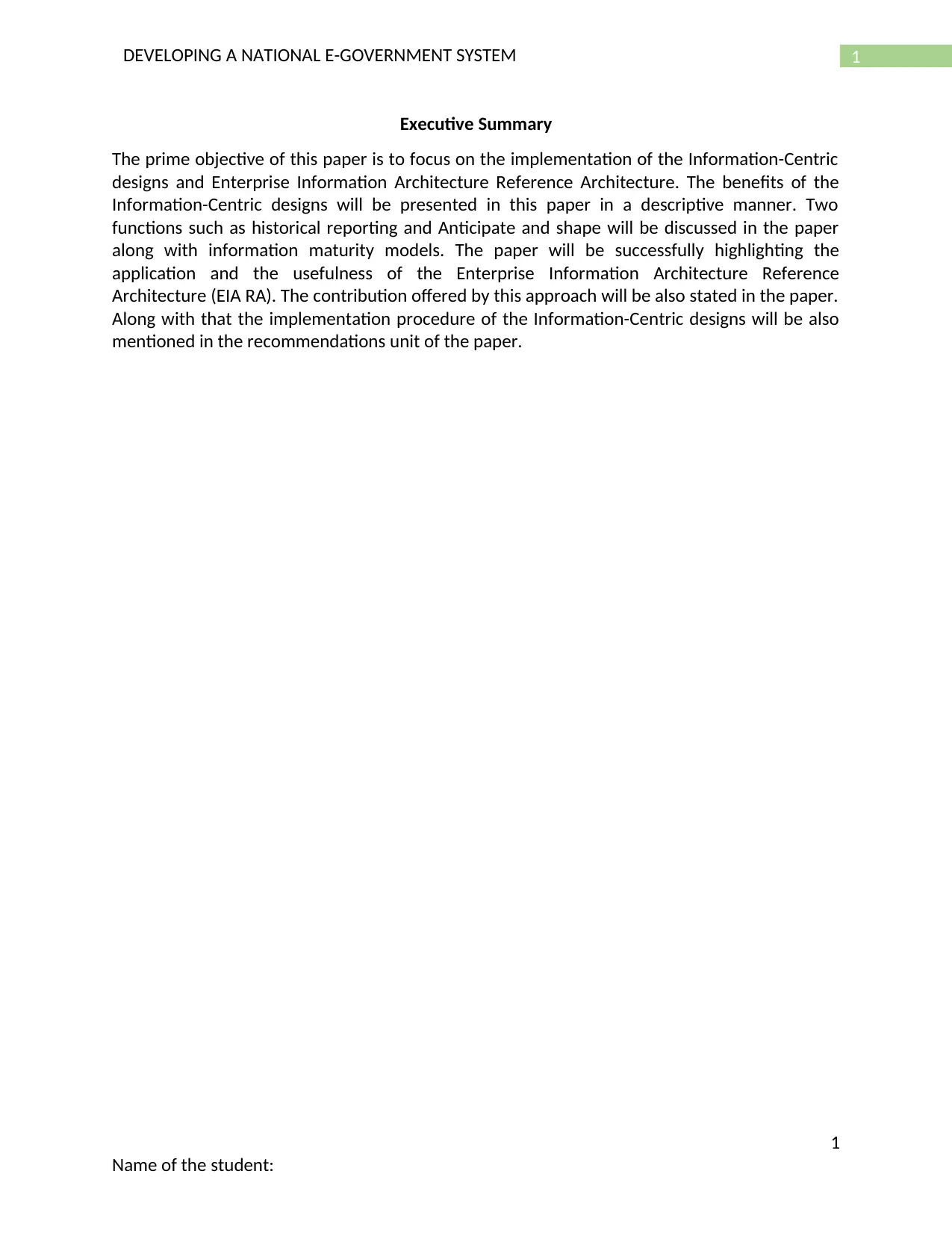
1DEVELOPING A NATIONAL E-GOVERNMENT SYSTEM
Executive Summary
The prime objective of this paper is to focus on the implementation of the Information-Centric
designs and Enterprise Information Architecture Reference Architecture. The benefits of the
Information-Centric designs will be presented in this paper in a descriptive manner. Two
functions such as historical reporting and Anticipate and shape will be discussed in the paper
along with information maturity models. The paper will be successfully highlighting the
application and the usefulness of the Enterprise Information Architecture Reference
Architecture (EIA RA). The contribution offered by this approach will be also stated in the paper.
Along with that the implementation procedure of the Information-Centric designs will be also
mentioned in the recommendations unit of the paper.
1
Name of the student:
Executive Summary
The prime objective of this paper is to focus on the implementation of the Information-Centric
designs and Enterprise Information Architecture Reference Architecture. The benefits of the
Information-Centric designs will be presented in this paper in a descriptive manner. Two
functions such as historical reporting and Anticipate and shape will be discussed in the paper
along with information maturity models. The paper will be successfully highlighting the
application and the usefulness of the Enterprise Information Architecture Reference
Architecture (EIA RA). The contribution offered by this approach will be also stated in the paper.
Along with that the implementation procedure of the Information-Centric designs will be also
mentioned in the recommendations unit of the paper.
1
Name of the student:
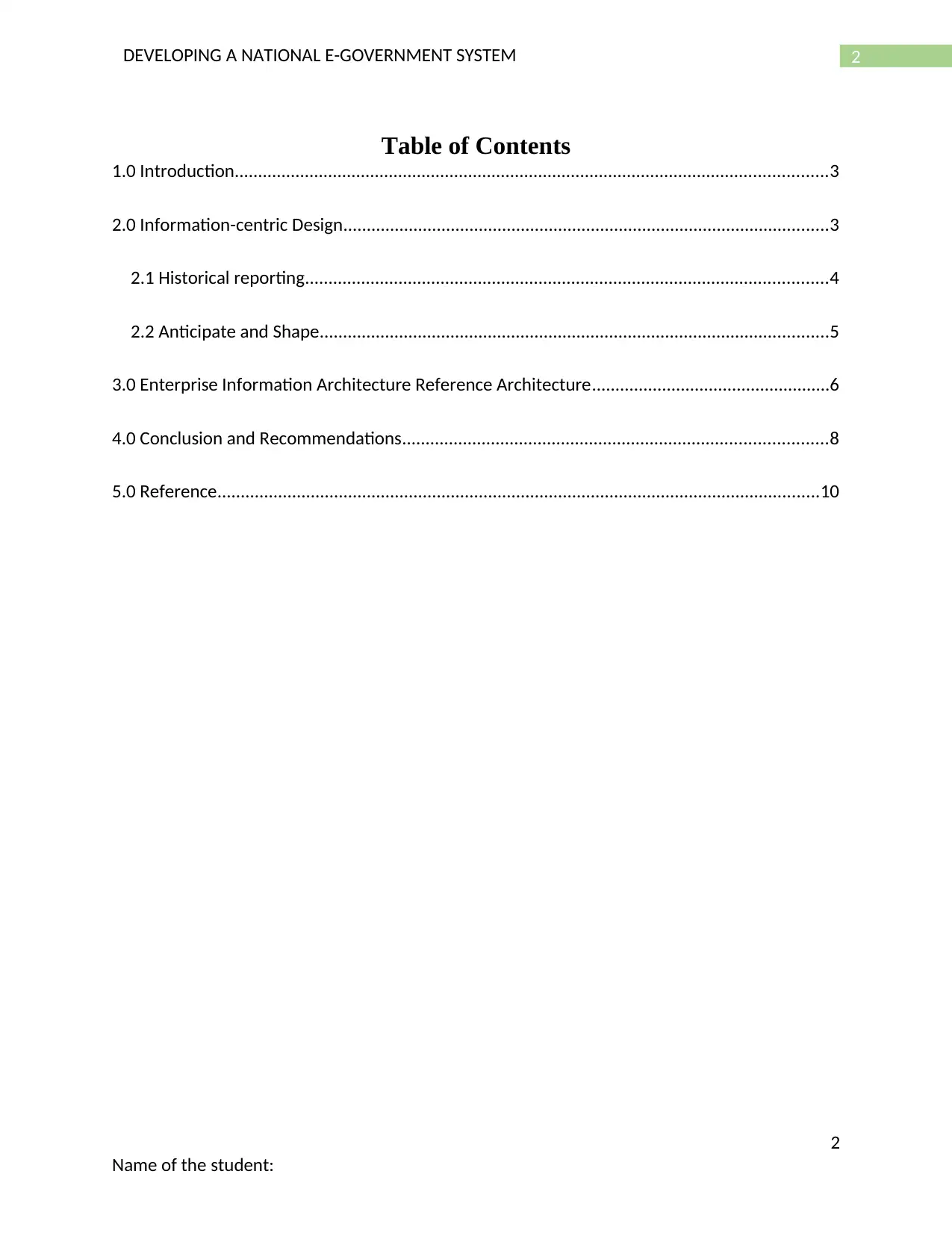
2DEVELOPING A NATIONAL E-GOVERNMENT SYSTEM
Table of Contents
1.0 Introduction...............................................................................................................................3
2.0 Information-centric Design........................................................................................................3
2.1 Historical reporting................................................................................................................4
2.2 Anticipate and Shape.............................................................................................................5
3.0 Enterprise Information Architecture Reference Architecture...................................................6
4.0 Conclusion and Recommendations...........................................................................................8
5.0 Reference.................................................................................................................................10
2
Name of the student:
Table of Contents
1.0 Introduction...............................................................................................................................3
2.0 Information-centric Design........................................................................................................3
2.1 Historical reporting................................................................................................................4
2.2 Anticipate and Shape.............................................................................................................5
3.0 Enterprise Information Architecture Reference Architecture...................................................6
4.0 Conclusion and Recommendations...........................................................................................8
5.0 Reference.................................................................................................................................10
2
Name of the student:
⊘ This is a preview!⊘
Do you want full access?
Subscribe today to unlock all pages.

Trusted by 1+ million students worldwide
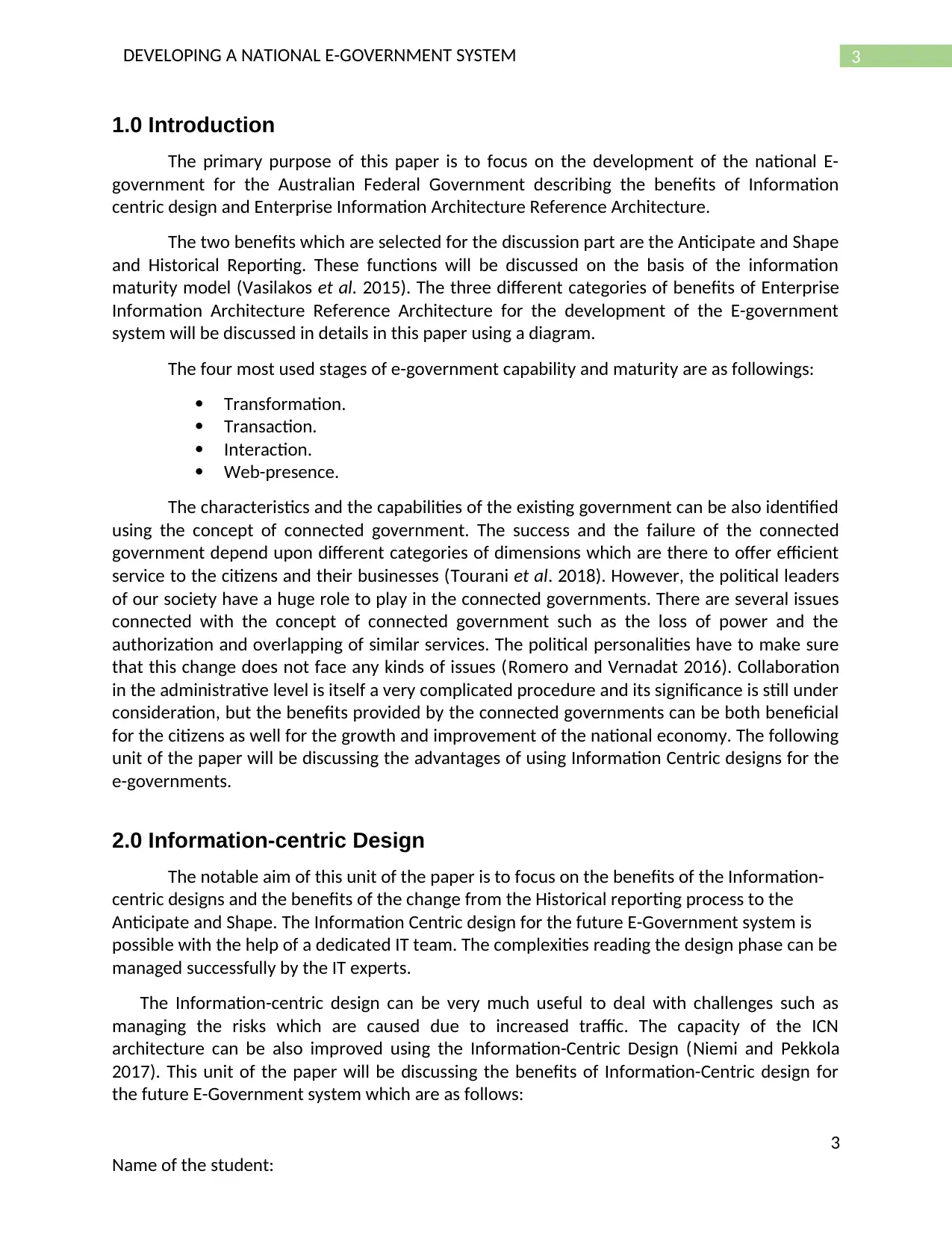
3DEVELOPING A NATIONAL E-GOVERNMENT SYSTEM
1.0 Introduction
The primary purpose of this paper is to focus on the development of the national E-
government for the Australian Federal Government describing the benefits of Information
centric design and Enterprise Information Architecture Reference Architecture.
The two benefits which are selected for the discussion part are the Anticipate and Shape
and Historical Reporting. These functions will be discussed on the basis of the information
maturity model (Vasilakos et al. 2015). The three different categories of benefits of Enterprise
Information Architecture Reference Architecture for the development of the E-government
system will be discussed in details in this paper using a diagram.
The four most used stages of e-government capability and maturity are as followings:
Transformation.
Transaction.
Interaction.
Web-presence.
The characteristics and the capabilities of the existing government can be also identified
using the concept of connected government. The success and the failure of the connected
government depend upon different categories of dimensions which are there to offer efficient
service to the citizens and their businesses (Tourani et al. 2018). However, the political leaders
of our society have a huge role to play in the connected governments. There are several issues
connected with the concept of connected government such as the loss of power and the
authorization and overlapping of similar services. The political personalities have to make sure
that this change does not face any kinds of issues (Romero and Vernadat 2016). Collaboration
in the administrative level is itself a very complicated procedure and its significance is still under
consideration, but the benefits provided by the connected governments can be both beneficial
for the citizens as well for the growth and improvement of the national economy. The following
unit of the paper will be discussing the advantages of using Information Centric designs for the
e-governments.
2.0 Information-centric Design
The notable aim of this unit of the paper is to focus on the benefits of the Information-
centric designs and the benefits of the change from the Historical reporting process to the
Anticipate and Shape. The Information Centric design for the future E-Government system is
possible with the help of a dedicated IT team. The complexities reading the design phase can be
managed successfully by the IT experts.
The Information-centric design can be very much useful to deal with challenges such as
managing the risks which are caused due to increased traffic. The capacity of the ICN
architecture can be also improved using the Information-Centric Design (Niemi and Pekkola
2017). This unit of the paper will be discussing the benefits of Information-Centric design for
the future E-Government system which are as follows:
3
Name of the student:
1.0 Introduction
The primary purpose of this paper is to focus on the development of the national E-
government for the Australian Federal Government describing the benefits of Information
centric design and Enterprise Information Architecture Reference Architecture.
The two benefits which are selected for the discussion part are the Anticipate and Shape
and Historical Reporting. These functions will be discussed on the basis of the information
maturity model (Vasilakos et al. 2015). The three different categories of benefits of Enterprise
Information Architecture Reference Architecture for the development of the E-government
system will be discussed in details in this paper using a diagram.
The four most used stages of e-government capability and maturity are as followings:
Transformation.
Transaction.
Interaction.
Web-presence.
The characteristics and the capabilities of the existing government can be also identified
using the concept of connected government. The success and the failure of the connected
government depend upon different categories of dimensions which are there to offer efficient
service to the citizens and their businesses (Tourani et al. 2018). However, the political leaders
of our society have a huge role to play in the connected governments. There are several issues
connected with the concept of connected government such as the loss of power and the
authorization and overlapping of similar services. The political personalities have to make sure
that this change does not face any kinds of issues (Romero and Vernadat 2016). Collaboration
in the administrative level is itself a very complicated procedure and its significance is still under
consideration, but the benefits provided by the connected governments can be both beneficial
for the citizens as well for the growth and improvement of the national economy. The following
unit of the paper will be discussing the advantages of using Information Centric designs for the
e-governments.
2.0 Information-centric Design
The notable aim of this unit of the paper is to focus on the benefits of the Information-
centric designs and the benefits of the change from the Historical reporting process to the
Anticipate and Shape. The Information Centric design for the future E-Government system is
possible with the help of a dedicated IT team. The complexities reading the design phase can be
managed successfully by the IT experts.
The Information-centric design can be very much useful to deal with challenges such as
managing the risks which are caused due to increased traffic. The capacity of the ICN
architecture can be also improved using the Information-Centric Design (Niemi and Pekkola
2017). This unit of the paper will be discussing the benefits of Information-Centric design for
the future E-Government system which are as follows:
3
Name of the student:
Paraphrase This Document
Need a fresh take? Get an instant paraphrase of this document with our AI Paraphraser
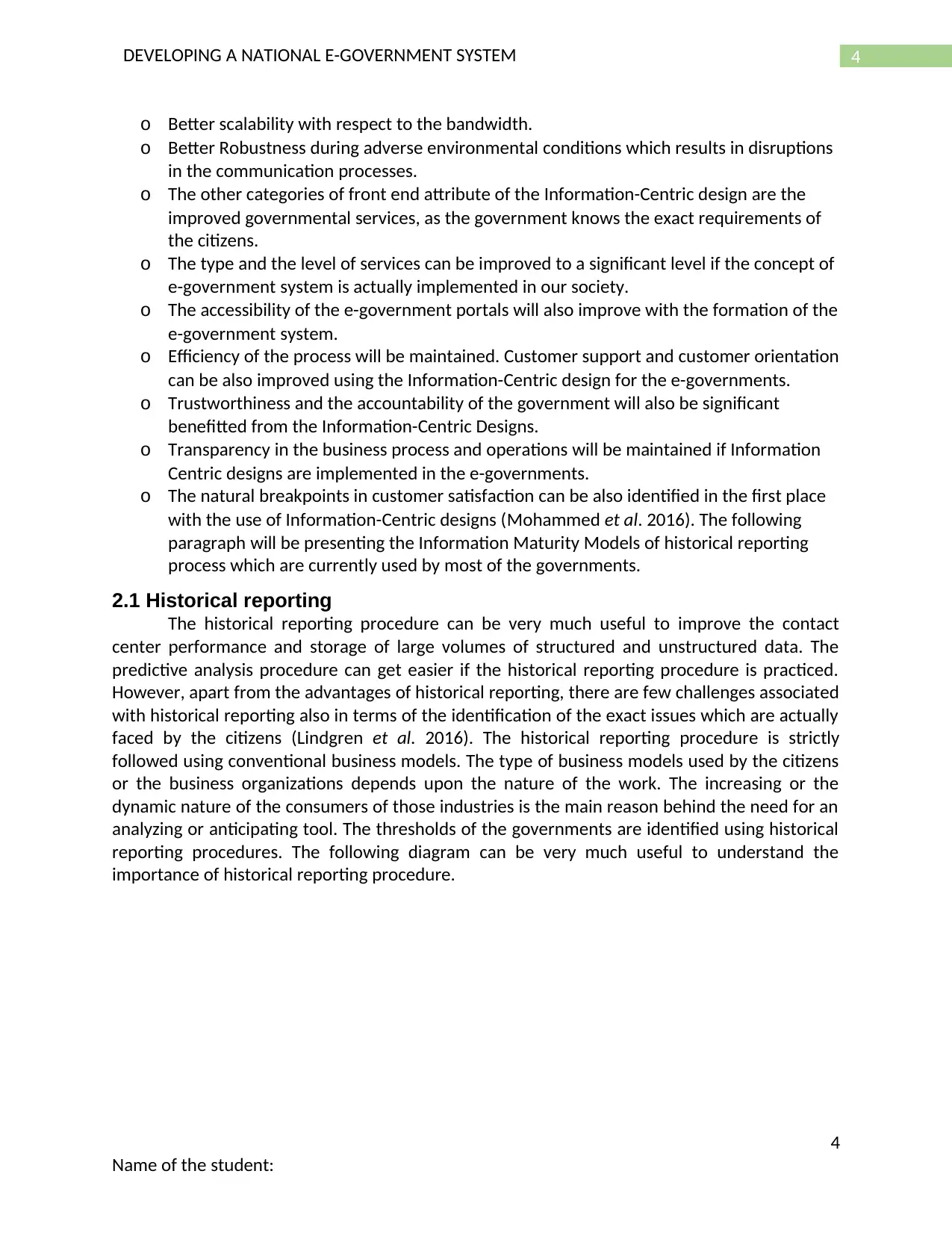
4DEVELOPING A NATIONAL E-GOVERNMENT SYSTEM
o Better scalability with respect to the bandwidth.
o Better Robustness during adverse environmental conditions which results in disruptions
in the communication processes.
o The other categories of front end attribute of the Information-Centric design are the
improved governmental services, as the government knows the exact requirements of
the citizens.
o The type and the level of services can be improved to a significant level if the concept of
e-government system is actually implemented in our society.
o The accessibility of the e-government portals will also improve with the formation of the
e-government system.
o Efficiency of the process will be maintained. Customer support and customer orientation
can be also improved using the Information-Centric design for the e-governments.
o Trustworthiness and the accountability of the government will also be significant
benefitted from the Information-Centric Designs.
o Transparency in the business process and operations will be maintained if Information
Centric designs are implemented in the e-governments.
o The natural breakpoints in customer satisfaction can be also identified in the first place
with the use of Information-Centric designs (Mohammed et al. 2016). The following
paragraph will be presenting the Information Maturity Models of historical reporting
process which are currently used by most of the governments.
2.1 Historical reporting
The historical reporting procedure can be very much useful to improve the contact
center performance and storage of large volumes of structured and unstructured data. The
predictive analysis procedure can get easier if the historical reporting procedure is practiced.
However, apart from the advantages of historical reporting, there are few challenges associated
with historical reporting also in terms of the identification of the exact issues which are actually
faced by the citizens (Lindgren et al. 2016). The historical reporting procedure is strictly
followed using conventional business models. The type of business models used by the citizens
or the business organizations depends upon the nature of the work. The increasing or the
dynamic nature of the consumers of those industries is the main reason behind the need for an
analyzing or anticipating tool. The thresholds of the governments are identified using historical
reporting procedures. The following diagram can be very much useful to understand the
importance of historical reporting procedure.
4
Name of the student:
o Better scalability with respect to the bandwidth.
o Better Robustness during adverse environmental conditions which results in disruptions
in the communication processes.
o The other categories of front end attribute of the Information-Centric design are the
improved governmental services, as the government knows the exact requirements of
the citizens.
o The type and the level of services can be improved to a significant level if the concept of
e-government system is actually implemented in our society.
o The accessibility of the e-government portals will also improve with the formation of the
e-government system.
o Efficiency of the process will be maintained. Customer support and customer orientation
can be also improved using the Information-Centric design for the e-governments.
o Trustworthiness and the accountability of the government will also be significant
benefitted from the Information-Centric Designs.
o Transparency in the business process and operations will be maintained if Information
Centric designs are implemented in the e-governments.
o The natural breakpoints in customer satisfaction can be also identified in the first place
with the use of Information-Centric designs (Mohammed et al. 2016). The following
paragraph will be presenting the Information Maturity Models of historical reporting
process which are currently used by most of the governments.
2.1 Historical reporting
The historical reporting procedure can be very much useful to improve the contact
center performance and storage of large volumes of structured and unstructured data. The
predictive analysis procedure can get easier if the historical reporting procedure is practiced.
However, apart from the advantages of historical reporting, there are few challenges associated
with historical reporting also in terms of the identification of the exact issues which are actually
faced by the citizens (Lindgren et al. 2016). The historical reporting procedure is strictly
followed using conventional business models. The type of business models used by the citizens
or the business organizations depends upon the nature of the work. The increasing or the
dynamic nature of the consumers of those industries is the main reason behind the need for an
analyzing or anticipating tool. The thresholds of the governments are identified using historical
reporting procedures. The following diagram can be very much useful to understand the
importance of historical reporting procedure.
4
Name of the student:
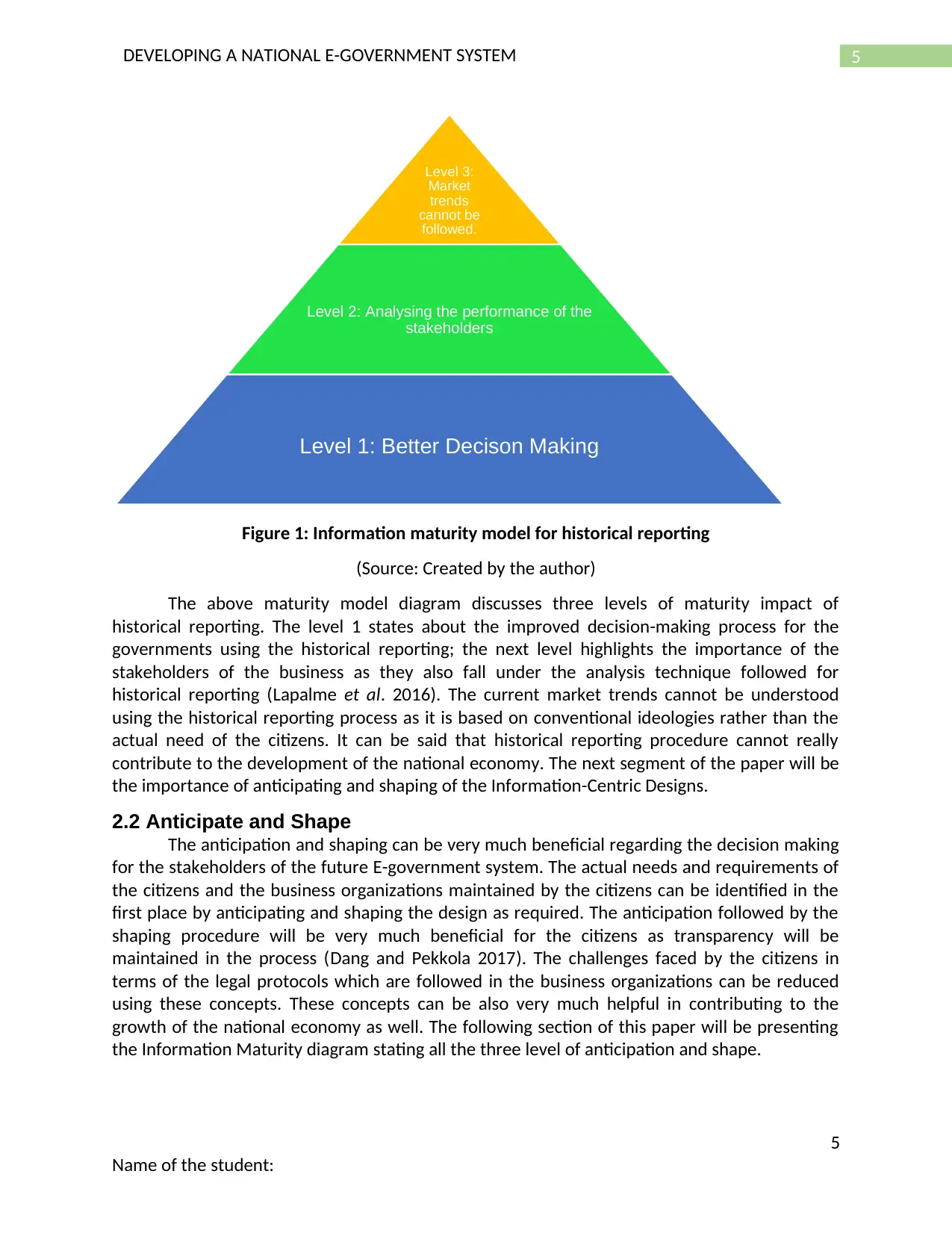
5DEVELOPING A NATIONAL E-GOVERNMENT SYSTEM
Figure 1: Information maturity model for historical reporting
(Source: Created by the author)
The above maturity model diagram discusses three levels of maturity impact of
historical reporting. The level 1 states about the improved decision-making process for the
governments using the historical reporting; the next level highlights the importance of the
stakeholders of the business as they also fall under the analysis technique followed for
historical reporting (Lapalme et al. 2016). The current market trends cannot be understood
using the historical reporting process as it is based on conventional ideologies rather than the
actual need of the citizens. It can be said that historical reporting procedure cannot really
contribute to the development of the national economy. The next segment of the paper will be
the importance of anticipating and shaping of the Information-Centric Designs.
2.2 Anticipate and Shape
The anticipation and shaping can be very much beneficial regarding the decision making
for the stakeholders of the future E-government system. The actual needs and requirements of
the citizens and the business organizations maintained by the citizens can be identified in the
first place by anticipating and shaping the design as required. The anticipation followed by the
shaping procedure will be very much beneficial for the citizens as transparency will be
maintained in the process (Dang and Pekkola 2017). The challenges faced by the citizens in
terms of the legal protocols which are followed in the business organizations can be reduced
using these concepts. These concepts can be also very much helpful in contributing to the
growth of the national economy as well. The following section of this paper will be presenting
the Information Maturity diagram stating all the three level of anticipation and shape.
5
Name of the student:
Level 3:
Market
trends
cannot be
followed.
Level 2: Analysing the performance of the
stakeholders
Level 1: Better Decison Making
Figure 1: Information maturity model for historical reporting
(Source: Created by the author)
The above maturity model diagram discusses three levels of maturity impact of
historical reporting. The level 1 states about the improved decision-making process for the
governments using the historical reporting; the next level highlights the importance of the
stakeholders of the business as they also fall under the analysis technique followed for
historical reporting (Lapalme et al. 2016). The current market trends cannot be understood
using the historical reporting process as it is based on conventional ideologies rather than the
actual need of the citizens. It can be said that historical reporting procedure cannot really
contribute to the development of the national economy. The next segment of the paper will be
the importance of anticipating and shaping of the Information-Centric Designs.
2.2 Anticipate and Shape
The anticipation and shaping can be very much beneficial regarding the decision making
for the stakeholders of the future E-government system. The actual needs and requirements of
the citizens and the business organizations maintained by the citizens can be identified in the
first place by anticipating and shaping the design as required. The anticipation followed by the
shaping procedure will be very much beneficial for the citizens as transparency will be
maintained in the process (Dang and Pekkola 2017). The challenges faced by the citizens in
terms of the legal protocols which are followed in the business organizations can be reduced
using these concepts. These concepts can be also very much helpful in contributing to the
growth of the national economy as well. The following section of this paper will be presenting
the Information Maturity diagram stating all the three level of anticipation and shape.
5
Name of the student:
Level 3:
Market
trends
cannot be
followed.
Level 2: Analysing the performance of the
stakeholders
Level 1: Better Decison Making
⊘ This is a preview!⊘
Do you want full access?
Subscribe today to unlock all pages.

Trusted by 1+ million students worldwide
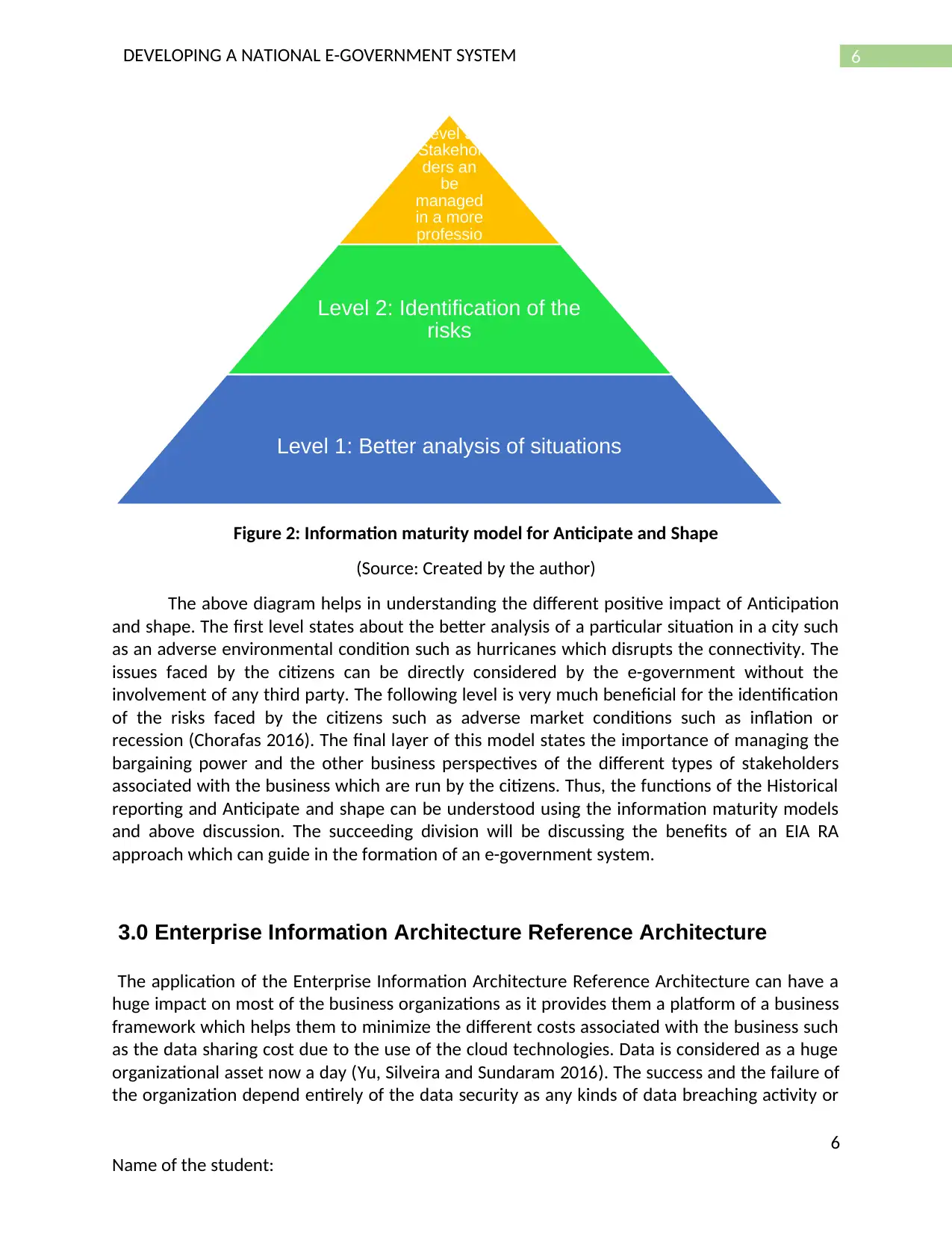
6DEVELOPING A NATIONAL E-GOVERNMENT SYSTEM
Figure 2: Information maturity model for Anticipate and Shape
(Source: Created by the author)
The above diagram helps in understanding the different positive impact of Anticipation
and shape. The first level states about the better analysis of a particular situation in a city such
as an adverse environmental condition such as hurricanes which disrupts the connectivity. The
issues faced by the citizens can be directly considered by the e-government without the
involvement of any third party. The following level is very much beneficial for the identification
of the risks faced by the citizens such as adverse market conditions such as inflation or
recession (Chorafas 2016). The final layer of this model states the importance of managing the
bargaining power and the other business perspectives of the different types of stakeholders
associated with the business which are run by the citizens. Thus, the functions of the Historical
reporting and Anticipate and shape can be understood using the information maturity models
and above discussion. The succeeding division will be discussing the benefits of an EIA RA
approach which can guide in the formation of an e-government system.
3.0 Enterprise Information Architecture Reference Architecture
The application of the Enterprise Information Architecture Reference Architecture can have a
huge impact on most of the business organizations as it provides them a platform of a business
framework which helps them to minimize the different costs associated with the business such
as the data sharing cost due to the use of the cloud technologies. Data is considered as a huge
organizational asset now a day (Yu, Silveira and Sundaram 2016). The success and the failure of
the organization depend entirely of the data security as any kinds of data breaching activity or
6
Name of the student:
Level 3:
Stakehol
ders an
be
managed
in a more
professio
nal
manner
Level 2: Identification of the
risks
Level 1: Better analysis of situations
Figure 2: Information maturity model for Anticipate and Shape
(Source: Created by the author)
The above diagram helps in understanding the different positive impact of Anticipation
and shape. The first level states about the better analysis of a particular situation in a city such
as an adverse environmental condition such as hurricanes which disrupts the connectivity. The
issues faced by the citizens can be directly considered by the e-government without the
involvement of any third party. The following level is very much beneficial for the identification
of the risks faced by the citizens such as adverse market conditions such as inflation or
recession (Chorafas 2016). The final layer of this model states the importance of managing the
bargaining power and the other business perspectives of the different types of stakeholders
associated with the business which are run by the citizens. Thus, the functions of the Historical
reporting and Anticipate and shape can be understood using the information maturity models
and above discussion. The succeeding division will be discussing the benefits of an EIA RA
approach which can guide in the formation of an e-government system.
3.0 Enterprise Information Architecture Reference Architecture
The application of the Enterprise Information Architecture Reference Architecture can have a
huge impact on most of the business organizations as it provides them a platform of a business
framework which helps them to minimize the different costs associated with the business such
as the data sharing cost due to the use of the cloud technologies. Data is considered as a huge
organizational asset now a day (Yu, Silveira and Sundaram 2016). The success and the failure of
the organization depend entirely of the data security as any kinds of data breaching activity or
6
Name of the student:
Level 3:
Stakehol
ders an
be
managed
in a more
professio
nal
manner
Level 2: Identification of the
risks
Level 1: Better analysis of situations
Paraphrase This Document
Need a fresh take? Get an instant paraphrase of this document with our AI Paraphraser
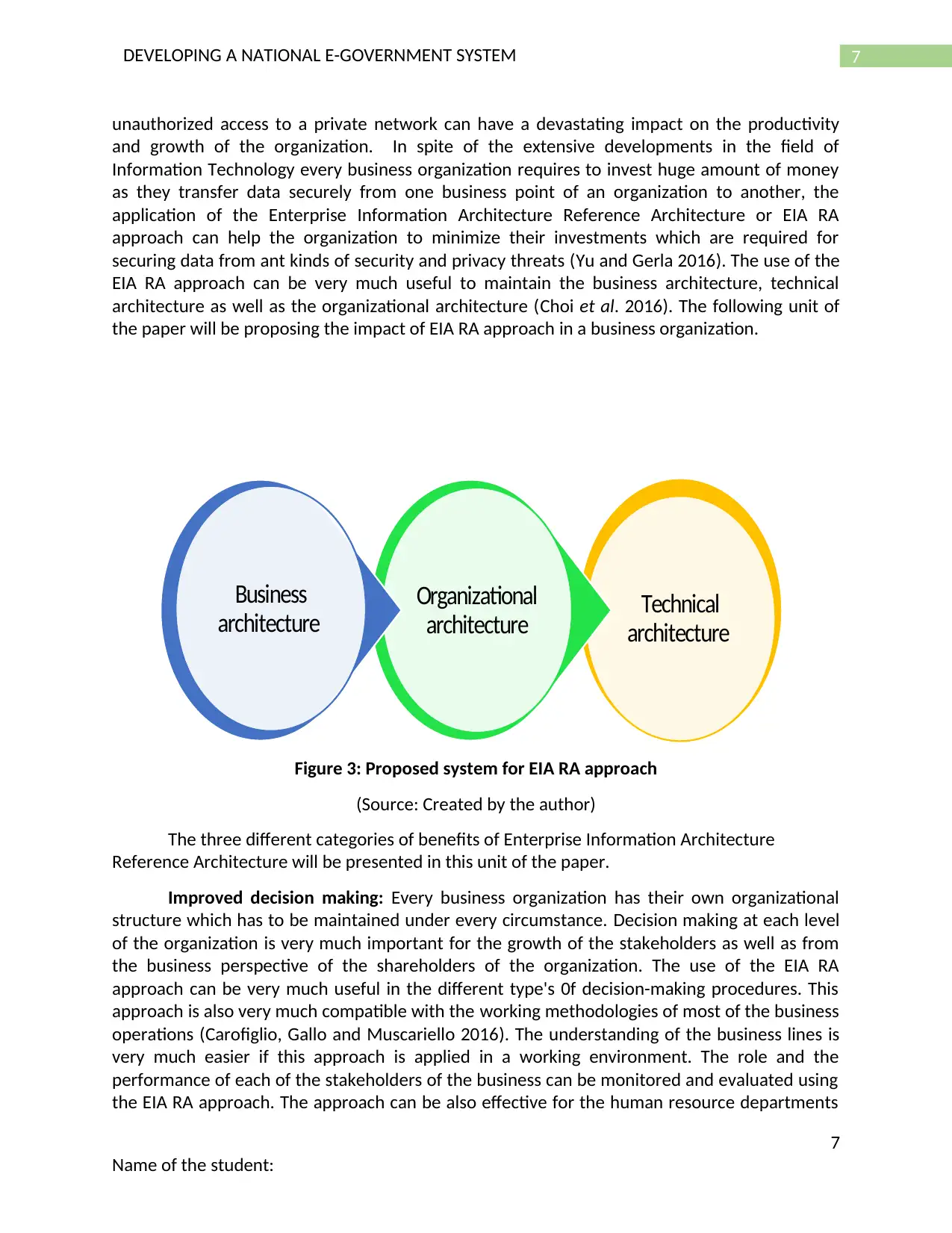
7DEVELOPING A NATIONAL E-GOVERNMENT SYSTEM
unauthorized access to a private network can have a devastating impact on the productivity
and growth of the organization. In spite of the extensive developments in the field of
Information Technology every business organization requires to invest huge amount of money
as they transfer data securely from one business point of an organization to another, the
application of the Enterprise Information Architecture Reference Architecture or EIA RA
approach can help the organization to minimize their investments which are required for
securing data from ant kinds of security and privacy threats (Yu and Gerla 2016). The use of the
EIA RA approach can be very much useful to maintain the business architecture, technical
architecture as well as the organizational architecture (Choi et al. 2016). The following unit of
the paper will be proposing the impact of EIA RA approach in a business organization.
Figure 3: Proposed system for EIA RA approach
(Source: Created by the author)
The three different categories of benefits of Enterprise Information Architecture
Reference Architecture will be presented in this unit of the paper.
Improved decision making: Every business organization has their own organizational
structure which has to be maintained under every circumstance. Decision making at each level
of the organization is very much important for the growth of the stakeholders as well as from
the business perspective of the shareholders of the organization. The use of the EIA RA
approach can be very much useful in the different type's 0f decision-making procedures. This
approach is also very much compatible with the working methodologies of most of the business
operations (Carofiglio, Gallo and Muscariello 2016). The understanding of the business lines is
very much easier if this approach is applied in a working environment. The role and the
performance of each of the stakeholders of the business can be monitored and evaluated using
the EIA RA approach. The approach can be also effective for the human resource departments
7
Name of the student:
Technical
architecture
Organizational
architecture
Business
architecture
unauthorized access to a private network can have a devastating impact on the productivity
and growth of the organization. In spite of the extensive developments in the field of
Information Technology every business organization requires to invest huge amount of money
as they transfer data securely from one business point of an organization to another, the
application of the Enterprise Information Architecture Reference Architecture or EIA RA
approach can help the organization to minimize their investments which are required for
securing data from ant kinds of security and privacy threats (Yu and Gerla 2016). The use of the
EIA RA approach can be very much useful to maintain the business architecture, technical
architecture as well as the organizational architecture (Choi et al. 2016). The following unit of
the paper will be proposing the impact of EIA RA approach in a business organization.
Figure 3: Proposed system for EIA RA approach
(Source: Created by the author)
The three different categories of benefits of Enterprise Information Architecture
Reference Architecture will be presented in this unit of the paper.
Improved decision making: Every business organization has their own organizational
structure which has to be maintained under every circumstance. Decision making at each level
of the organization is very much important for the growth of the stakeholders as well as from
the business perspective of the shareholders of the organization. The use of the EIA RA
approach can be very much useful in the different type's 0f decision-making procedures. This
approach is also very much compatible with the working methodologies of most of the business
operations (Carofiglio, Gallo and Muscariello 2016). The understanding of the business lines is
very much easier if this approach is applied in a working environment. The role and the
performance of each of the stakeholders of the business can be monitored and evaluated using
the EIA RA approach. The approach can be also effective for the human resource departments
7
Name of the student:
Technical
architecture
Organizational
architecture
Business
architecture
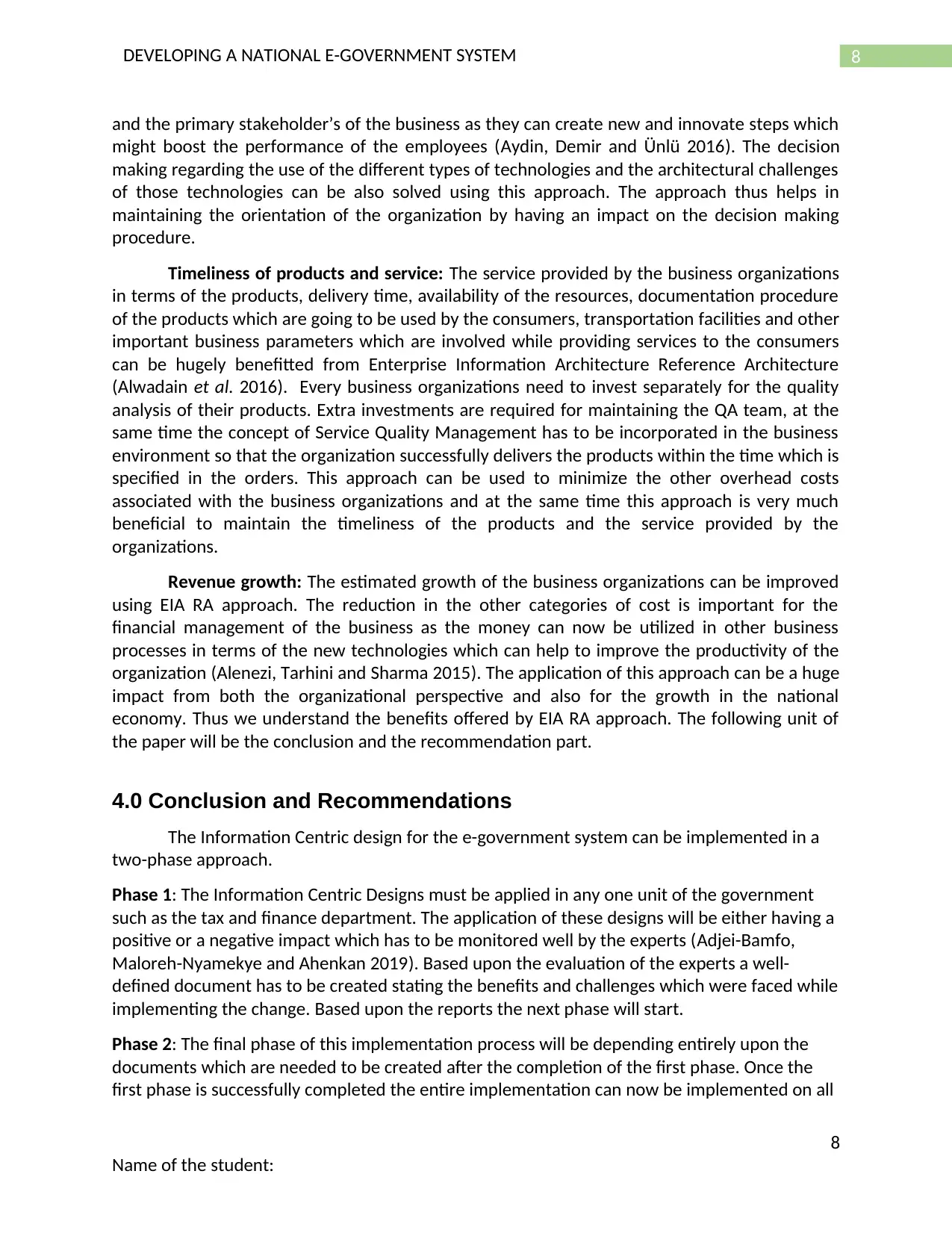
8DEVELOPING A NATIONAL E-GOVERNMENT SYSTEM
and the primary stakeholder’s of the business as they can create new and innovate steps which
might boost the performance of the employees (Aydin, Demir and Ünlü 2016). The decision
making regarding the use of the different types of technologies and the architectural challenges
of those technologies can be also solved using this approach. The approach thus helps in
maintaining the orientation of the organization by having an impact on the decision making
procedure.
Timeliness of products and service: The service provided by the business organizations
in terms of the products, delivery time, availability of the resources, documentation procedure
of the products which are going to be used by the consumers, transportation facilities and other
important business parameters which are involved while providing services to the consumers
can be hugely benefitted from Enterprise Information Architecture Reference Architecture
(Alwadain et al. 2016). Every business organizations need to invest separately for the quality
analysis of their products. Extra investments are required for maintaining the QA team, at the
same time the concept of Service Quality Management has to be incorporated in the business
environment so that the organization successfully delivers the products within the time which is
specified in the orders. This approach can be used to minimize the other overhead costs
associated with the business organizations and at the same time this approach is very much
beneficial to maintain the timeliness of the products and the service provided by the
organizations.
Revenue growth: The estimated growth of the business organizations can be improved
using EIA RA approach. The reduction in the other categories of cost is important for the
financial management of the business as the money can now be utilized in other business
processes in terms of the new technologies which can help to improve the productivity of the
organization (Alenezi, Tarhini and Sharma 2015). The application of this approach can be a huge
impact from both the organizational perspective and also for the growth in the national
economy. Thus we understand the benefits offered by EIA RA approach. The following unit of
the paper will be the conclusion and the recommendation part.
4.0 Conclusion and Recommendations
The Information Centric design for the e-government system can be implemented in a
two-phase approach.
Phase 1: The Information Centric Designs must be applied in any one unit of the government
such as the tax and finance department. The application of these designs will be either having a
positive or a negative impact which has to be monitored well by the experts (Adjei-Bamfo,
Maloreh-Nyamekye and Ahenkan 2019). Based upon the evaluation of the experts a well-
defined document has to be created stating the benefits and challenges which were faced while
implementing the change. Based upon the reports the next phase will start.
Phase 2: The final phase of this implementation process will be depending entirely upon the
documents which are needed to be created after the completion of the first phase. Once the
first phase is successfully completed the entire implementation can now be implemented on all
8
Name of the student:
and the primary stakeholder’s of the business as they can create new and innovate steps which
might boost the performance of the employees (Aydin, Demir and Ünlü 2016). The decision
making regarding the use of the different types of technologies and the architectural challenges
of those technologies can be also solved using this approach. The approach thus helps in
maintaining the orientation of the organization by having an impact on the decision making
procedure.
Timeliness of products and service: The service provided by the business organizations
in terms of the products, delivery time, availability of the resources, documentation procedure
of the products which are going to be used by the consumers, transportation facilities and other
important business parameters which are involved while providing services to the consumers
can be hugely benefitted from Enterprise Information Architecture Reference Architecture
(Alwadain et al. 2016). Every business organizations need to invest separately for the quality
analysis of their products. Extra investments are required for maintaining the QA team, at the
same time the concept of Service Quality Management has to be incorporated in the business
environment so that the organization successfully delivers the products within the time which is
specified in the orders. This approach can be used to minimize the other overhead costs
associated with the business organizations and at the same time this approach is very much
beneficial to maintain the timeliness of the products and the service provided by the
organizations.
Revenue growth: The estimated growth of the business organizations can be improved
using EIA RA approach. The reduction in the other categories of cost is important for the
financial management of the business as the money can now be utilized in other business
processes in terms of the new technologies which can help to improve the productivity of the
organization (Alenezi, Tarhini and Sharma 2015). The application of this approach can be a huge
impact from both the organizational perspective and also for the growth in the national
economy. Thus we understand the benefits offered by EIA RA approach. The following unit of
the paper will be the conclusion and the recommendation part.
4.0 Conclusion and Recommendations
The Information Centric design for the e-government system can be implemented in a
two-phase approach.
Phase 1: The Information Centric Designs must be applied in any one unit of the government
such as the tax and finance department. The application of these designs will be either having a
positive or a negative impact which has to be monitored well by the experts (Adjei-Bamfo,
Maloreh-Nyamekye and Ahenkan 2019). Based upon the evaluation of the experts a well-
defined document has to be created stating the benefits and challenges which were faced while
implementing the change. Based upon the reports the next phase will start.
Phase 2: The final phase of this implementation process will be depending entirely upon the
documents which are needed to be created after the completion of the first phase. Once the
first phase is successfully completed the entire implementation can now be implemented on all
8
Name of the student:
⊘ This is a preview!⊘
Do you want full access?
Subscribe today to unlock all pages.

Trusted by 1+ million students worldwide
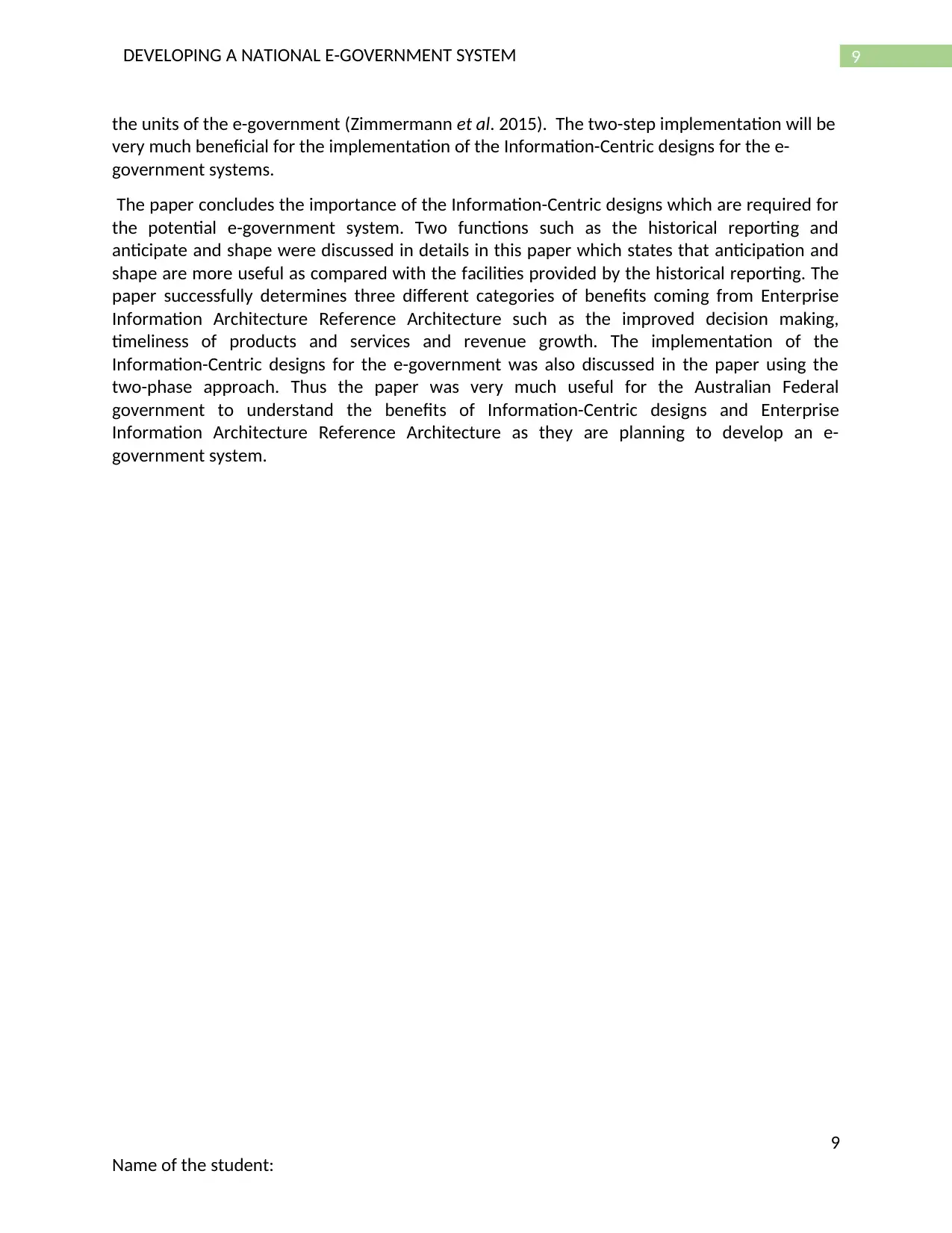
9DEVELOPING A NATIONAL E-GOVERNMENT SYSTEM
the units of the e-government (Zimmermann et al. 2015). The two-step implementation will be
very much beneficial for the implementation of the Information-Centric designs for the e-
government systems.
The paper concludes the importance of the Information-Centric designs which are required for
the potential e-government system. Two functions such as the historical reporting and
anticipate and shape were discussed in details in this paper which states that anticipation and
shape are more useful as compared with the facilities provided by the historical reporting. The
paper successfully determines three different categories of benefits coming from Enterprise
Information Architecture Reference Architecture such as the improved decision making,
timeliness of products and services and revenue growth. The implementation of the
Information-Centric designs for the e-government was also discussed in the paper using the
two-phase approach. Thus the paper was very much useful for the Australian Federal
government to understand the benefits of Information-Centric designs and Enterprise
Information Architecture Reference Architecture as they are planning to develop an e-
government system.
9
Name of the student:
the units of the e-government (Zimmermann et al. 2015). The two-step implementation will be
very much beneficial for the implementation of the Information-Centric designs for the e-
government systems.
The paper concludes the importance of the Information-Centric designs which are required for
the potential e-government system. Two functions such as the historical reporting and
anticipate and shape were discussed in details in this paper which states that anticipation and
shape are more useful as compared with the facilities provided by the historical reporting. The
paper successfully determines three different categories of benefits coming from Enterprise
Information Architecture Reference Architecture such as the improved decision making,
timeliness of products and services and revenue growth. The implementation of the
Information-Centric designs for the e-government was also discussed in the paper using the
two-phase approach. Thus the paper was very much useful for the Australian Federal
government to understand the benefits of Information-Centric designs and Enterprise
Information Architecture Reference Architecture as they are planning to develop an e-
government system.
9
Name of the student:
Paraphrase This Document
Need a fresh take? Get an instant paraphrase of this document with our AI Paraphraser
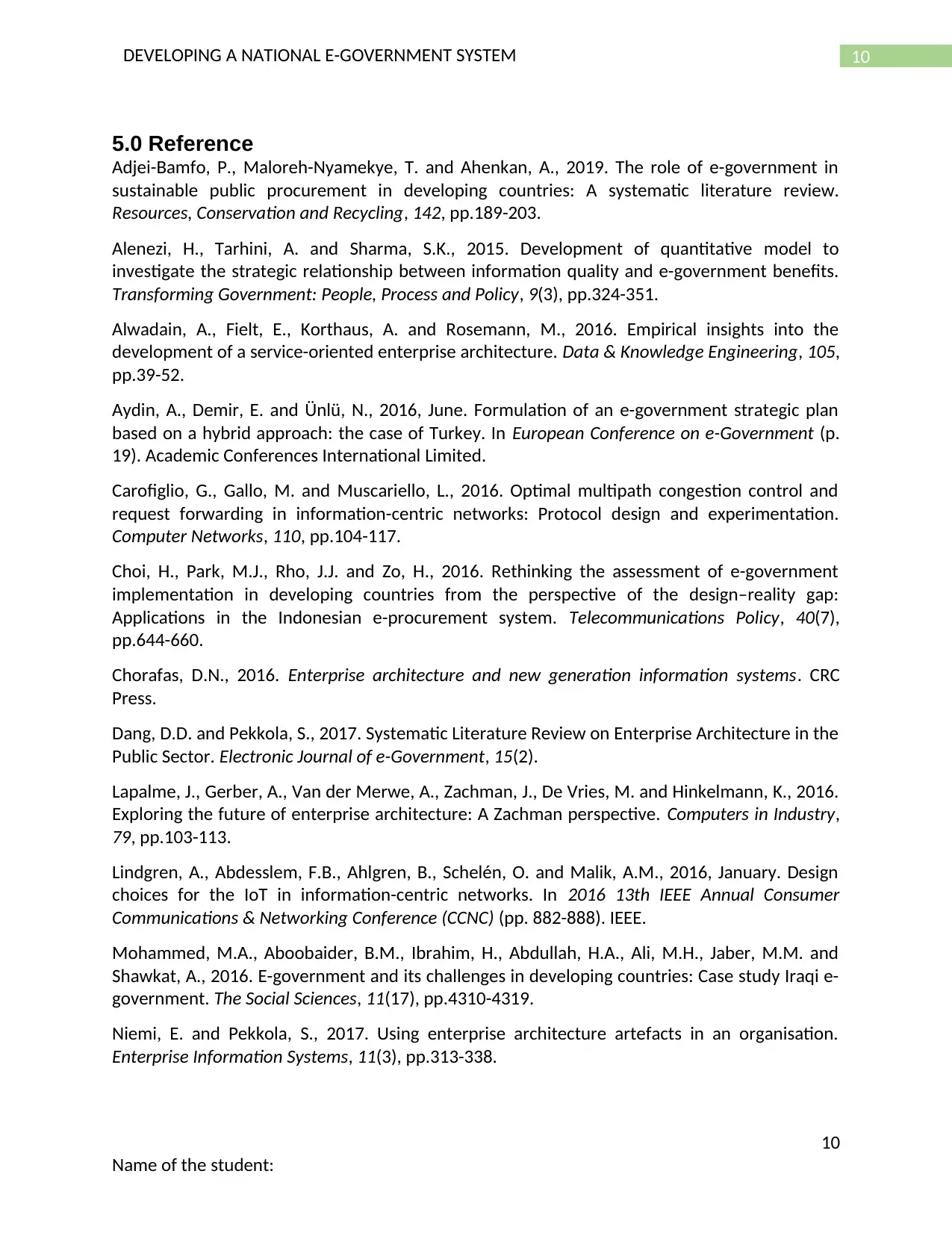
10DEVELOPING A NATIONAL E-GOVERNMENT SYSTEM
5.0 Reference
Adjei-Bamfo, P., Maloreh-Nyamekye, T. and Ahenkan, A., 2019. The role of e-government in
sustainable public procurement in developing countries: A systematic literature review.
Resources, Conservation and Recycling, 142, pp.189-203.
Alenezi, H., Tarhini, A. and Sharma, S.K., 2015. Development of quantitative model to
investigate the strategic relationship between information quality and e-government benefits.
Transforming Government: People, Process and Policy, 9(3), pp.324-351.
Alwadain, A., Fielt, E., Korthaus, A. and Rosemann, M., 2016. Empirical insights into the
development of a service-oriented enterprise architecture. Data & Knowledge Engineering, 105,
pp.39-52.
Aydin, A., Demir, E. and Ünlü, N., 2016, June. Formulation of an e-government strategic plan
based on a hybrid approach: the case of Turkey. In European Conference on e-Government (p.
19). Academic Conferences International Limited.
Carofiglio, G., Gallo, M. and Muscariello, L., 2016. Optimal multipath congestion control and
request forwarding in information-centric networks: Protocol design and experimentation.
Computer Networks, 110, pp.104-117.
Choi, H., Park, M.J., Rho, J.J. and Zo, H., 2016. Rethinking the assessment of e-government
implementation in developing countries from the perspective of the design–reality gap:
Applications in the Indonesian e-procurement system. Telecommunications Policy, 40(7),
pp.644-660.
Chorafas, D.N., 2016. Enterprise architecture and new generation information systems. CRC
Press.
Dang, D.D. and Pekkola, S., 2017. Systematic Literature Review on Enterprise Architecture in the
Public Sector. Electronic Journal of e-Government, 15(2).
Lapalme, J., Gerber, A., Van der Merwe, A., Zachman, J., De Vries, M. and Hinkelmann, K., 2016.
Exploring the future of enterprise architecture: A Zachman perspective. Computers in Industry,
79, pp.103-113.
Lindgren, A., Abdesslem, F.B., Ahlgren, B., Schelén, O. and Malik, A.M., 2016, January. Design
choices for the IoT in information-centric networks. In 2016 13th IEEE Annual Consumer
Communications & Networking Conference (CCNC) (pp. 882-888). IEEE.
Mohammed, M.A., Aboobaider, B.M., Ibrahim, H., Abdullah, H.A., Ali, M.H., Jaber, M.M. and
Shawkat, A., 2016. E-government and its challenges in developing countries: Case study Iraqi e-
government. The Social Sciences, 11(17), pp.4310-4319.
Niemi, E. and Pekkola, S., 2017. Using enterprise architecture artefacts in an organisation.
Enterprise Information Systems, 11(3), pp.313-338.
10
Name of the student:
5.0 Reference
Adjei-Bamfo, P., Maloreh-Nyamekye, T. and Ahenkan, A., 2019. The role of e-government in
sustainable public procurement in developing countries: A systematic literature review.
Resources, Conservation and Recycling, 142, pp.189-203.
Alenezi, H., Tarhini, A. and Sharma, S.K., 2015. Development of quantitative model to
investigate the strategic relationship between information quality and e-government benefits.
Transforming Government: People, Process and Policy, 9(3), pp.324-351.
Alwadain, A., Fielt, E., Korthaus, A. and Rosemann, M., 2016. Empirical insights into the
development of a service-oriented enterprise architecture. Data & Knowledge Engineering, 105,
pp.39-52.
Aydin, A., Demir, E. and Ünlü, N., 2016, June. Formulation of an e-government strategic plan
based on a hybrid approach: the case of Turkey. In European Conference on e-Government (p.
19). Academic Conferences International Limited.
Carofiglio, G., Gallo, M. and Muscariello, L., 2016. Optimal multipath congestion control and
request forwarding in information-centric networks: Protocol design and experimentation.
Computer Networks, 110, pp.104-117.
Choi, H., Park, M.J., Rho, J.J. and Zo, H., 2016. Rethinking the assessment of e-government
implementation in developing countries from the perspective of the design–reality gap:
Applications in the Indonesian e-procurement system. Telecommunications Policy, 40(7),
pp.644-660.
Chorafas, D.N., 2016. Enterprise architecture and new generation information systems. CRC
Press.
Dang, D.D. and Pekkola, S., 2017. Systematic Literature Review on Enterprise Architecture in the
Public Sector. Electronic Journal of e-Government, 15(2).
Lapalme, J., Gerber, A., Van der Merwe, A., Zachman, J., De Vries, M. and Hinkelmann, K., 2016.
Exploring the future of enterprise architecture: A Zachman perspective. Computers in Industry,
79, pp.103-113.
Lindgren, A., Abdesslem, F.B., Ahlgren, B., Schelén, O. and Malik, A.M., 2016, January. Design
choices for the IoT in information-centric networks. In 2016 13th IEEE Annual Consumer
Communications & Networking Conference (CCNC) (pp. 882-888). IEEE.
Mohammed, M.A., Aboobaider, B.M., Ibrahim, H., Abdullah, H.A., Ali, M.H., Jaber, M.M. and
Shawkat, A., 2016. E-government and its challenges in developing countries: Case study Iraqi e-
government. The Social Sciences, 11(17), pp.4310-4319.
Niemi, E. and Pekkola, S., 2017. Using enterprise architecture artefacts in an organisation.
Enterprise Information Systems, 11(3), pp.313-338.
10
Name of the student:
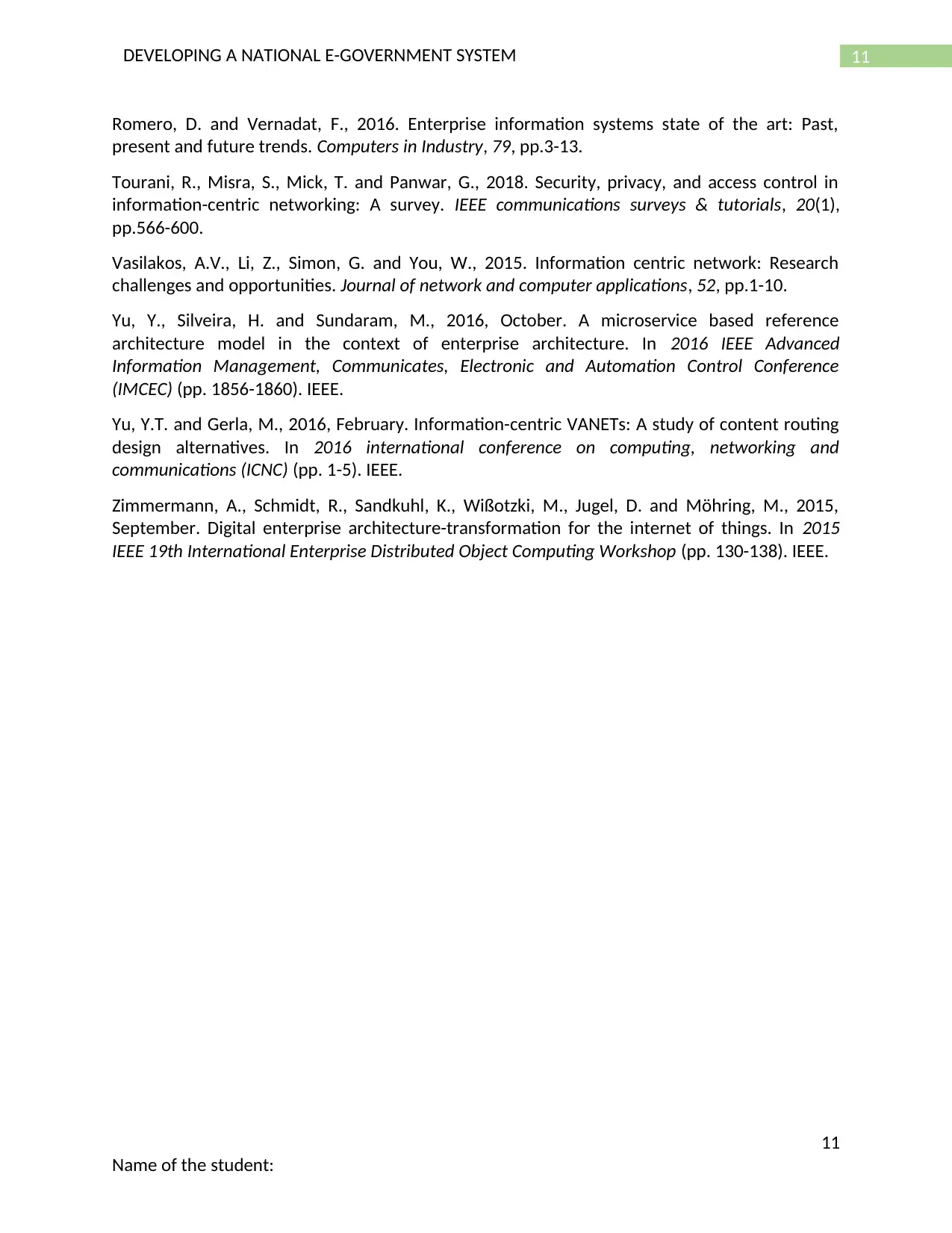
11DEVELOPING A NATIONAL E-GOVERNMENT SYSTEM
Romero, D. and Vernadat, F., 2016. Enterprise information systems state of the art: Past,
present and future trends. Computers in Industry, 79, pp.3-13.
Tourani, R., Misra, S., Mick, T. and Panwar, G., 2018. Security, privacy, and access control in
information-centric networking: A survey. IEEE communications surveys & tutorials, 20(1),
pp.566-600.
Vasilakos, A.V., Li, Z., Simon, G. and You, W., 2015. Information centric network: Research
challenges and opportunities. Journal of network and computer applications, 52, pp.1-10.
Yu, Y., Silveira, H. and Sundaram, M., 2016, October. A microservice based reference
architecture model in the context of enterprise architecture. In 2016 IEEE Advanced
Information Management, Communicates, Electronic and Automation Control Conference
(IMCEC) (pp. 1856-1860). IEEE.
Yu, Y.T. and Gerla, M., 2016, February. Information-centric VANETs: A study of content routing
design alternatives. In 2016 international conference on computing, networking and
communications (ICNC) (pp. 1-5). IEEE.
Zimmermann, A., Schmidt, R., Sandkuhl, K., Wißotzki, M., Jugel, D. and Möhring, M., 2015,
September. Digital enterprise architecture-transformation for the internet of things. In 2015
IEEE 19th International Enterprise Distributed Object Computing Workshop (pp. 130-138). IEEE.
11
Name of the student:
Romero, D. and Vernadat, F., 2016. Enterprise information systems state of the art: Past,
present and future trends. Computers in Industry, 79, pp.3-13.
Tourani, R., Misra, S., Mick, T. and Panwar, G., 2018. Security, privacy, and access control in
information-centric networking: A survey. IEEE communications surveys & tutorials, 20(1),
pp.566-600.
Vasilakos, A.V., Li, Z., Simon, G. and You, W., 2015. Information centric network: Research
challenges and opportunities. Journal of network and computer applications, 52, pp.1-10.
Yu, Y., Silveira, H. and Sundaram, M., 2016, October. A microservice based reference
architecture model in the context of enterprise architecture. In 2016 IEEE Advanced
Information Management, Communicates, Electronic and Automation Control Conference
(IMCEC) (pp. 1856-1860). IEEE.
Yu, Y.T. and Gerla, M., 2016, February. Information-centric VANETs: A study of content routing
design alternatives. In 2016 international conference on computing, networking and
communications (ICNC) (pp. 1-5). IEEE.
Zimmermann, A., Schmidt, R., Sandkuhl, K., Wißotzki, M., Jugel, D. and Möhring, M., 2015,
September. Digital enterprise architecture-transformation for the internet of things. In 2015
IEEE 19th International Enterprise Distributed Object Computing Workshop (pp. 130-138). IEEE.
11
Name of the student:
⊘ This is a preview!⊘
Do you want full access?
Subscribe today to unlock all pages.

Trusted by 1+ million students worldwide
1 out of 12
Related Documents
Your All-in-One AI-Powered Toolkit for Academic Success.
+13062052269
info@desklib.com
Available 24*7 on WhatsApp / Email
![[object Object]](/_next/static/media/star-bottom.7253800d.svg)
Unlock your academic potential
Copyright © 2020–2025 A2Z Services. All Rights Reserved. Developed and managed by ZUCOL.





